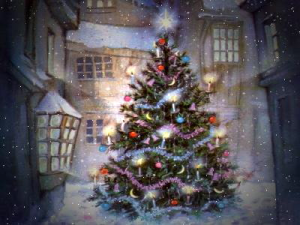There are reports of decorated fir trees before the Middle Ages. Some believe that the real beginning of the Christmas tree as we know it may be attributed to the 16th Century German theologian Martin Luther or another clergyman of his time.
The clergyman, according to legend, was walking through a forest at night and was overcome by the beauty of the green fir trees against the starlit sky above. When he arrived home, he wanted to recreate the beautiful scene for his children as he told them about his walk. So he brought a small fir tree into the house and decorated it with lighted candles.
 From this beginning, the custom of decorating a Christmas tree spread throughout Germany and into the rest of Europe.
From this beginning, the custom of decorating a Christmas tree spread throughout Germany and into the rest of Europe.
It was introduced into England by Prince Albert, Queen Victoria’s German husband, in 1841.
The German immigrants brought the treasured tradition with them to America, and Christmas trees have been a cherished part of our holiday season ever since.
The Christmas tree has gained in popularity in America since the middle of the 19th Century and is perhaps the foremost feature of Christmas celebrations.
Along with the bright lights, now much safer that the earlier candles, trees are decorated with colorful balls, religious symbols such as angels and crosses, glittering tinsel and chains of popcorn and cranberries.
Under the tree, in Christian homes, will frequently be found a creche of the nativity scene reminding us of the night Christ was born.
Anyone who has seen the beauty of a Christmas tree reflected in the wonder of a little child’s eyes knows it is among the most treasured of our traditions.